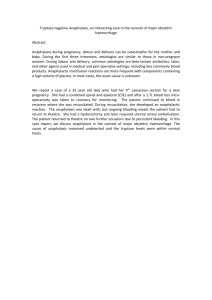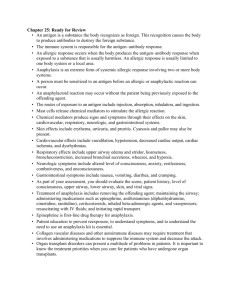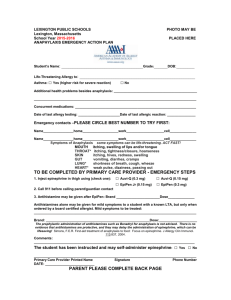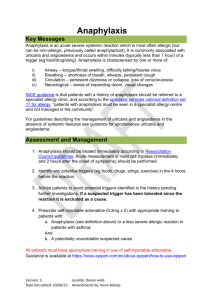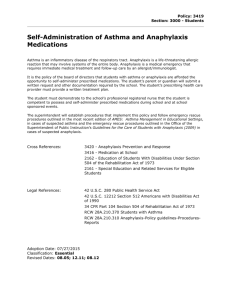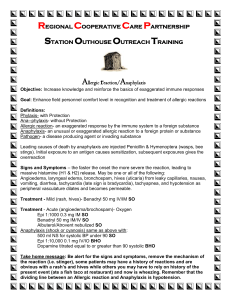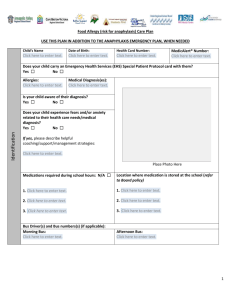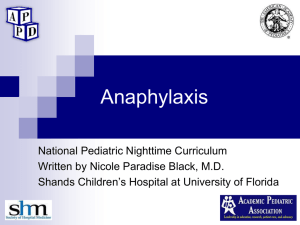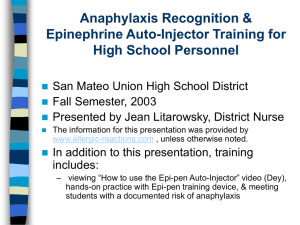2005 American Heart Association Guidelines for Cardiopulmonary
advertisement
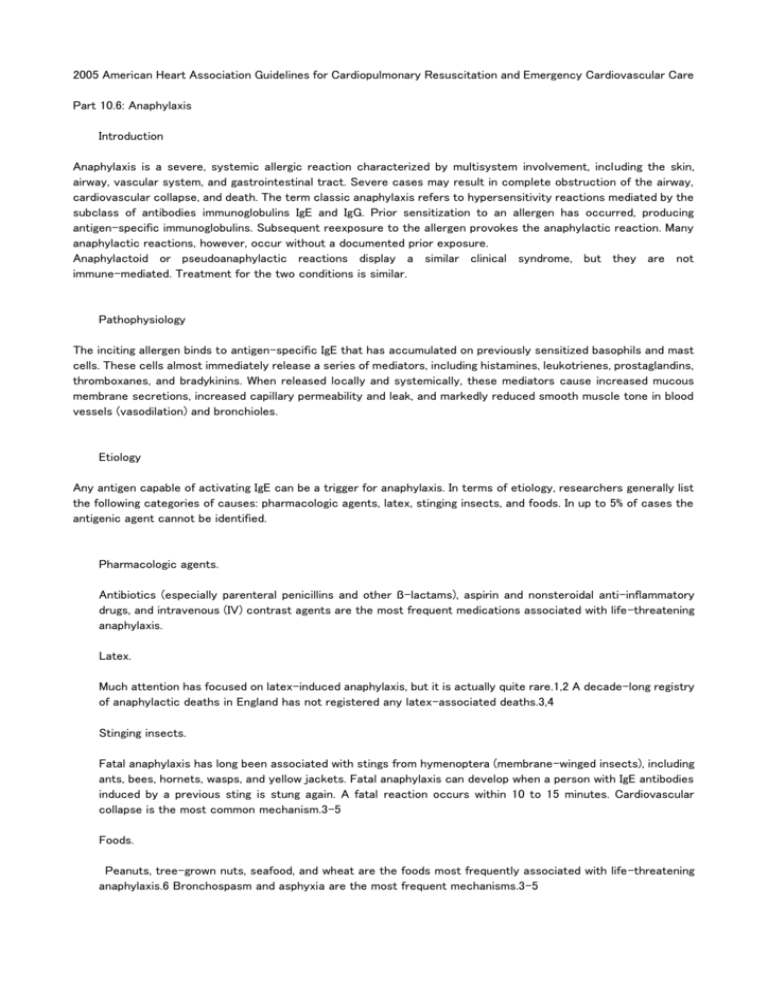
2005 American Heart Association Guidelines for Cardiopulmonary Resuscitation and Emergency Cardiovascular Care Part 10.6: Anaphylaxis Introduction Anaphylaxis is a severe, systemic allergic reaction characterized by multisystem involvement, including the skin, airway, vascular system, and gastrointestinal tract. Severe cases may result in complete obstruction of the airway, cardiovascular collapse, and death. The term classic anaphylaxis refers to hypersensitivity reactions mediated by the subclass of antibodies immunoglobulins IgE and IgG. Prior sensitization to an allergen has occurred, producing antigen-specific immunoglobulins. Subsequent reexposure to the allergen provokes the anaphylactic reaction. Many anaphylactic reactions, however, occur without a documented prior exposure. Anaphylactoid or pseudoanaphylactic reactions display a similar clinical syndrome, but they are not immune-mediated. Treatment for the two conditions is similar. Pathophysiology The inciting allergen binds to antigen-specific IgE that has accumulated on previously sensitized basophils and mast cells. These cells almost immediately release a series of mediators, including histamines, leukotrienes, prostaglandins, thromboxanes, and bradykinins. When released locally and systemically, these mediators cause increased mucous membrane secretions, increased capillary permeability and leak, and markedly reduced smooth muscle tone in blood vessels (vasodilation) and bronchioles. Etiology Any antigen capable of activating IgE can be a trigger for anaphylaxis. In terms of etiology, researchers generally list the following categories of causes: pharmacologic agents, latex, stinging insects, and foods. In up to 5% of cases the antigenic agent cannot be identified. Pharmacologic agents. Antibiotics (especially parenteral penicillins and other ß-lactams), aspirin and nonsteroidal anti-inflammatory drugs, and intravenous (IV) contrast agents are the most frequent medications associated with life-threatening anaphylaxis. Latex. Much attention has focused on latex-induced anaphylaxis, but it is actually quite rare.1,2 A decade-long registry of anaphylactic deaths in England has not registered any latex-associated deaths.3,4 Stinging insects. Fatal anaphylaxis has long been associated with stings from hymenoptera (membrane-winged insects), including ants, bees, hornets, wasps, and yellow jackets. Fatal anaphylaxis can develop when a person with IgE antibodies induced by a previous sting is stung again. A fatal reaction occurs within 10 to 15 minutes. Cardiovascular collapse is the most common mechanism.3–5 Foods. Peanuts, tree-grown nuts, seafood, and wheat are the foods most frequently associated with life-threatening anaphylaxis.6 Bronchospasm and asphyxia are the most frequent mechanisms.3–5 Signs and Symptoms Consider anaphylaxis when responses from 2 or more body systems (cutaneous, respiratory, cardiovascular, neurologic, or gastrointestinal) are noted; the cardiovascular and respiratory systems may not be involved. The shorter the interval between exposure and reaction, the more likely the reaction is to be severe. Signs and symptoms include the following: ・Serious upper airway (laryngeal) edema, lower airway edema (asthma), or both may develop, causing stridor and wheezing. Rhinitis is often an early sign of respiratory involvement. ・Cardiovascular collapse is the most common periarrest manifestation. Vasodilation produces a relative hypovolemia. Increased capillary permeability contributes to further intravascular volume loss. The patient may be agitated or anxious and may appear either flushed or pale. Additional cardiac dysfunction may result from underlying disease or the development of myocardial ischemia from administration of epinephrine.3–5 ・Gastrointestinal signs and symptoms of anaphylaxis include abdominal pain, vomiting, and diarrhea. Differential Diagnoses A number of disease processes produce some of the signs and symptoms of anaphylaxis. Only after the clinician eliminates anaphylaxis as a diagnosis should the other conditions be considered, because failure to identify and appropriately treat anaphylaxis can be fatal.7,8 ・Scombroid poisoning often develops within 30 minutes of eating spoiled fish, including tuna, mackerel, or dolphin (mahi-mahi). Typically scombroid poisoning presents with urticaria, nausea, vomiting, diarrhea, and headache. It is treated with antihistamines. ・Angioedema that seems to occur in families is termed hereditary angioedema. This hereditary form is indistinguishable from the early angioedema of anaphylaxis or medication-related angioedema. Urticaria does not occur with hereditary angioedema, however. Angioedema is treated with C1 esterase inhibitor replacement concentrate if available. Otherwise, fresh frozen plasma may be used. ・Angiotensin-converting enzyme (ACE) inhibitors are associated with a reactive angioedema predominantly of the upper airway. This reaction can develop days or years after ACE inhibitor therapy is begun. The best treatment for this form of angioedema is unclear, but aggressive early airway management is critical.9 ・Severe, near-fatal asthma attacks can present with bronchospasm and stridor. In general, asthma attacks do not present with urticaria or angioedema. Asthma treatment is very different from treatment of anaphylaxis even though the mechanism of immunologic hypersensitivity may be common to both. ・In some forms of panic disorder, functional stridor develops as a result of forced adduction of the vocal cords. In a panic attack there is no urticaria, angioedema, hypoxia, or hypotension. ・Along with anaphylaxis, consider vasovagal reactions. Urticaria, angioedema, and bronchospasm are not present in vasovagal reactions. Interventions to Prevent Cardiopulmonary Arrest Recommendations to prevent cardiopulmonary arrest are difficult to standardize because etiology, clinical presentation (including severity and course), and organ involvement vary widely. Few randomized trials of treatment approaches have been reported. Providers, however, must be aware that the patient can deteriorate quickly and that urgent support of airway, breathing, and circulation are essential. The following therapies are commonly used and widely accepted but are based more on consensus than evidence: ・Oxygen. Administer oxygen at high flow rates. ・Epinephrine –Absorption and subsequent achievement of maximum plasma concentration after subcutaneous administration is slower and may be significantly delayed with shock.10,11 Thus, intramuscular (IM) administration is favored. ・Administer epinephrine by IM injection early to all patients with signs of a systemic reaction, especially hypotension, airway swelling, or definite difficulty breathing. ・Use an IM dose of 0.3 to 0.5 mg (1:1000) repeated every 15 to 20 minutes if there is no clinical improvement. –Administer IV epinephrine if anaphylaxis appears to be severe with immediate life-threatening manifestations.12 ・Use epinephrine (1:10 000) 0.1 mg IV slowly over 5 minutes. Epinephrine may be diluted to a 1:10 000 solution before infusion. ・An IV infusion at rates of 1 to 4 µg/min may prevent the need to repeat epinephrine injections frequently.13 –Close monitoring is critical because fatal overdose of epinephrine has been reported.3,14 –Patients who are taking ß-blockers have increased incidence and severity of anaphylaxis and can develop a paradoxical response to epinephrine.15 Consider glucagon as well as ipratropium for these patients (see below). Aggressive fluid resuscitation. Give isotonic crystalloid (eg, normal saline) if hypotension is present and does not respond rapidly to epinephrine. A rapid infusion of 1 to 2 L or even 4 L may be needed initially. Antihistamines. Administer antihistamines slowly IV or IM (eg, 25 to 50 mg of diphenhydramine). H2 blockers. Administer H2 blockers such as cimetidine (300 mg orally, IM, or IV).16 Inhaled ß-adrenergic agents. Provide inhaled albuterol if bronchospasm is a major feature. Inhaled ipratropium may be especially useful for treatment of bronchospasm in patients receiving ß-blockers. Note that some patients treated for near-fatal asthma actually had anaphylaxis, so they received repeated doses of conventional bronchodilators rather than epinephrine.17 Corticosteroids. Infuse high-dose IV corticosteroids early in the course of therapy. Beneficial effects are delayed at least 4 to 6 hours. Removal of venom sac. Insect envenomation by bees (but not wasps) may leave a venom sac attached to the victim’s skin. At some point during initial assessment, look at the sting site, and if you see a stinger, immediately scrape it or any insect parts at the site of the sting, using the dull edge of a knife.18 Avoid compressing or squeezing any insect parts near the skin because squeezing may increase envenomation. Potential Therapies ・Vasopressin. There are case reports that vasopressin may benefit severely hypotensive patients.19,20 ・Atropine. Case reports suggest that when relative or severe bradycardia is present, there may be a role for administration of atropine.8 ・Glucagon. For patients who are unresponsive to epinephrine, especially those receiving ß-blockers, glucagon may be effective. This agent is short-acting; give 1 to 2 mg every 5 minutes IM or IV. Nausea, vomiting, and hyperglycemia are common side effects. Observation Patients who respond to therapy require observation, but there is no evidence to suggest the length of observation time needed. Symptoms may recur in some patients (up to 20%) within 1 to 8 hours (biphasic response) despite an intervening asymptomatic period. Biphasic responses have been reported to occur up to 36 hours after the initial reaction.15,16,21–24 A patient who remains symptom-free for 4 hours after treatment may be discharged.25 Severity of reaction or other problems, however, may necessitate longer periods of observation. Airway Obstruction Early elective intubation is recommended for patients observed to develop hoarseness, lingual edema, stridor, or oropharyngeal swelling. Patients with angioedema pose a particularly worrisome problem because they are at high risk for rapid deterioration. Most will present with some degree of labial or facial swelling. Patients with hoarseness, lingual edema, and oropharyngeal swelling are at particular risk for respiratory compromise. Patients can deteriorate over a brief period of time ( to 3 hours), with progressive development of stridor, dysphonia or aphonia, laryngeal edema, massive lingual swelling, facial and neck swelling, and hypoxemia. This may occur when patients have a delayed presentation to the hospital or fail to respond to therapy. At this point use of either the laryngeal mask airway or the Combitube will be ineffective, and endotracheal intubation and cricothyrotomy may be difficult or impossible. Attempts at endotracheal intubation may only further increase laryngeal edema or cause trauma to the airway. Early recognition of the potentially difficult airway allows planning for alternative airway management by those who are trained in these techniques, including consultation with anesthesia and an ear, nose, and throat specialist if the provider is unfamiliar with advanced airway techniques. Cardiac Arrest If cardiac arrest develops, CPR, volume administration, and adrenergic drugs are the cornerstones of therapy. Critical therapies are as follows: ・ Aggressive volume expansion. Near-fatal anaphylaxis produces profound vasodilation that significantly increases intravascular capacity. Massive volume replacement is needed. Use at least 2 large-bore IVs with pressure bags to administer large volumes (typically between 4 and 8 L) of isotonic crystalloid as quickly as possible. ・High-dose epinephrine IV. Use a rapid progression to high dose without hesitation in patients in full cardiac arrest. A commonly used sequence is 1 to 3 mg IV (3 minutes), 3 to 5 mg IV (3 minutes), then 4 to 10 µg/min infusion. ・Antihistamine IV. There is little data about the value of antihistamines in anaphylactic cardiac arrest, but it is reasonable to assume that little additional harm could result.16 ・Steroid therapy. Steroids given during a cardiac arrest will have little effect, but they may have value in the early hours of any postresuscitation period. ・Asystole/Pulseless Electrical Activity (PEA) Algorithms. The arrest rhythm in anaphylaxis is often PEA or asystole. See the ACLS Pulseless Arrest Algorithm in Part 7.2: "Management of Cardiac Arrest." ・Prolonged CPR. Patients with anaphylaxis are often young with healthy hearts and cardiovascular systems, and they may respond to rapid correction of vasodilation and low intravascular volume. Effective CPR may maintain sufficient oxygen delivery until the catastrophic effects of the anaphylactic reaction resolve. Summary The management of anaphylaxis includes early recognition, anticipation of deterioration, and aggressive support of airway, oxygenation, ventilation, and circulation. Potential fatal complications include airway obstruction and cardiovascular collapse. Prompt, aggressive therapy may succeed even if cardiac arrest develops. Footnotes This special supplement to Circulation is freely available at http://www.circulationaha.org References 1. Dreyfus DH, Fraser B, Randolph CC. Anaphylaxis to latex in patients without identified risk factors for latex allergy. Conn Med. 2004;68: 217–222. 2. Ownby DR. A history of latex allergy. J Allergy Clin Immunol. 2002; 110:S27–S32. 3. Pumphrey RS. Lessons for management of anaphylaxis from a study of fatal reactions. Clin Exp Allergy. 2000;30:1144 –1150. 4. Pumphrey RS. Fatal anaphylaxis in the UK, 1992–2001. Novartis Found Symp. 2004;257:116 –128; discussion 128–132, 157–160, 276–185. 5. Pumphrey RS, Roberts IS. Postmortem findings after fatal anaphylactic reactions. J Clin Pathol. 2000;53:273–276. 6. Mullins RJ. Anaphylaxis: risk factors for recurrence. Clin Exp Allergy. 2003;33:1033–1040. 7. Brown AF. Anaphylaxis: quintessence, quarrels, and quandaries. Emerg Med J. 2001;18:328. 8. Brown AFT. Anaphylaxis gets the adrenaline going. Emerg Med J. 2004;21:128 –129. 9. Ishoo E, Shah UK, Grillone GA, Stram JR, Fuleiham NS. Predicting airway risk in angioedema: staging system based on presentation. Otolaryngol Head Neck Surg. 1999;121:263–268. 10. Simons FE, Gu X, Simons KJ. Epinephrine absorption in adults: intramuscular versus subcutaneous injection. J Allergy Clin Immunol. 2001; 108:871– 873. 11. Simons FE, Chan ES, Gu X, Simons KJ. Epinephrine for the out-ofhospital (first-aid) treatment of anaphylaxis in infants: is the ampule/ syringe/needle method practical? J Allergy Clin Immunol. 2001;108: 1040–1044. 12. Brown SG, Blackman KE, Stenlake V, Heddle RJ. Insect sting anaphylaxis; prospective evaluation of treatment with intravenous adrenaline and volume resuscitation. Emerg Med J. 2004;21:149 –154. 13. Barach EM, Nowak RM, Lee TG, Tomlanovich MM. Epinephrine for treatment of anaphylactic shock. JAMA. 1984;251:2118 –2122. 14. Pumphrey R. Anaphylaxis: can we tell who is at risk of a fatal reaction? Curr Opin Allergy Clin Immunol. 2004;4:285–290. 15. Ellis AK, Day JH. Diagnosis and management of anaphylaxis. CMAJ. 2003;169:307–311. 16. Winbery SL, Lieberman PL. Histamine and antihistamines in anaphylaxis. Clin Allergy Immunol. 2002;17:287–317. 17. Rainbow J, Browne GJ. Fatal asthma or anaphylaxis? Emerg Med J. 2002;19:415– 417. 18. Visscher PK, Vetter RS, Camazine S. Removing bee stings. Lancet. 1996;348:301–302. 19. Kill C, Wranze E, Wulf H. Successful treatment of severe anaphylactic shock with vasopressin: two case reports. Int Arch Allergy Immunol. 2004;134:260 –261. 20. Williams SR, Denault AY, Pellerin M, Martineau R. Vasopressin for treatment of shock following aprotinin administration. Can J Anaesth. 2004;51:169 –172. 21. Yocum MW, Butterfield JH, Klein JS, Volcheck GW, Schroeder DR, Silverstein MD. Epidemiology of anaphylaxis in Olmsted County: a population-based study. J Allergy Clin Immunol. 1999;104(pt 1):452– 456. 22. Smith PL, Kagey-Sobotka A, Bleecker ER, Traystman R, Kaplan AP, Gralnick H, Valentine MD, Permutt S, Lichtenstein LM. Physiologic manifestations of human anaphylaxis. J Clin Invest. 1980;66:1072–1080. 23. Stark BJ, Sullivan TJ. Biphasic and protracted anaphylaxis. J Allergy Clin Immunol. 1986;78:76–83. 24. Brazil E, MacNamara AF. ‘Not so immediate‘ hypersensitivity: the danger of biphasic anaphylactic reactions. J Accid Emerg Med. 1998;15: 252–253. 25. Brady WJ Jr, Luber S, Carter CT, Guertter A, Lindbeck G. Multiphasic anaphylaxis: an uncommon event in the emergency department. Acad Emerg Med. 1997;4:193–197.
